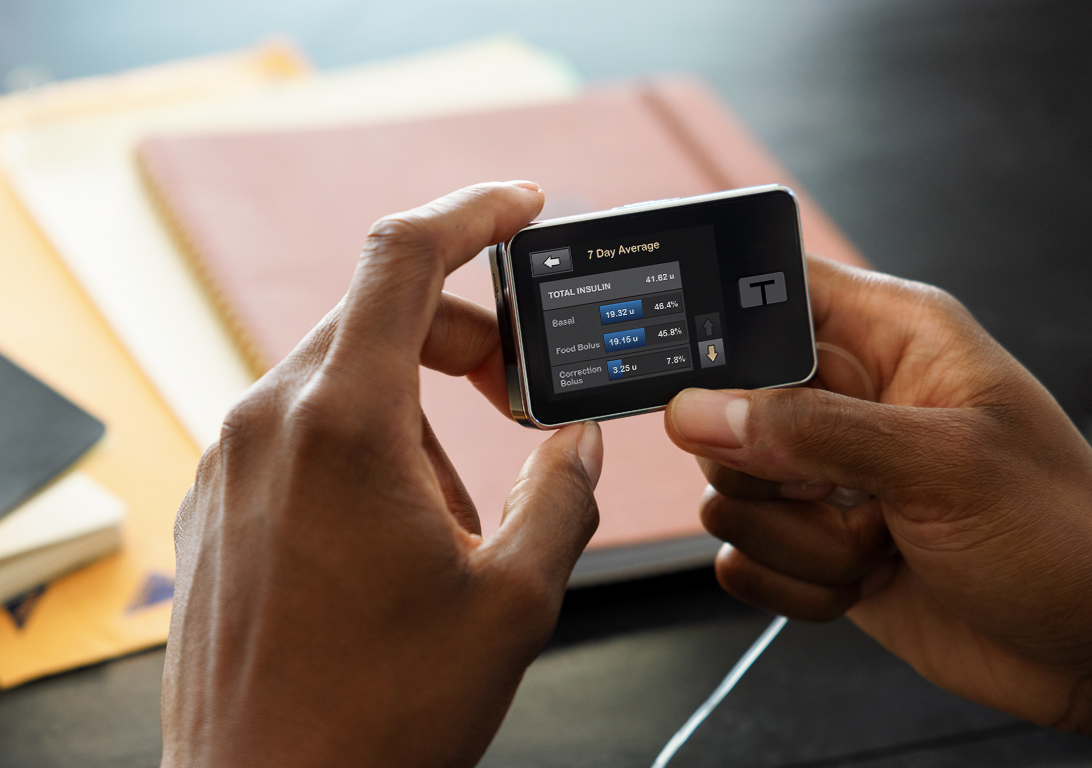During this tumultuous time, as our country and the world take action to flatten the curve of the coronavirus, Diabetes Care and Education Specialists are rapidly pivoting and quickly upskilling to employ virtual teaching techniques and tools to continue delivering diabetes care and education. At Tandem Diabetes Care, nearly 100 Clinical Diabetes Specialists are also rapidly adjusting to conducting all, not just some of their training, on the t:slim X2 insulin pump with Control-IQ technology virtually.
Tandem has made advancing technology for users a priority by offering downloadable remote software updates. Those updates, paired with remote demonstration tools, have helped clinical pump trainers activate in response to this pressing need.
In this part of this two-part article, several of Tandem's Clinical Diabetes Specialists share their best practices for delivering virtual training and support. We hope they’re helpful!

Category 1
Tips to Build Rapport with Teens
Erica Page, BS, BSN, RN, CDE, Clinical Training Manager
“Make sure the person you’re training is sharing their camera with you. This ensures you have their attention and helps you determine that you’re maintaining or starting
to lose their attention. If they’re using their smartphone to log in, ask them to enable the do not disturb feature. This prevents the temptation to respond to incoming texts or notifications.”
Marin Preston, RN, CDE (San Francisco)
“I start with questions that quickly help me learn more about the teen and their lifestyle. I gain more insight by asking why they made the decision to select this or that device.”
Jennifer Sirmans, RN, BSN, CDCES, Clinical Support Specialist
“Involve the teen as much as possible in the training and decision making. Use what you learned about their life and lifestyle in the content you teach, examples you use and
situations you present. Also stay focused on helping the teen manage their diabetes challenges. Don’t talk about the future.”
Kirsten Ward, MS, RCEP, CDE (Southern California)
“Don’t stress out, teens can be challenging! Find out what’s important to them and what they want to get out of the teaching session. Try to give them what they want or explain
why you can’t. Ask for permission to provide education and information. If they say no, honor their request. Use humor. Most teens can be sarcastic and aloof. Humor (without sarcasm) can win them over. Use technology if they like it. Amp up
your tech skills by showing videos, recommending apps. Give them choices. For example, let them choose some of their pump settings, like target ranges on reports, alarms/alerts on or off.”

Category 2
Accurate Use of Diabetes Devices
Techniques to implement return demonstration and teach back to confirm accurate use of diabetes devices (CGM, BGM, insulin pens, pumps, etc).
Jennifer Hyman, MS, RD, CDE, CDN (Long Island, New York)
“Provide gentle reminders for the person to watch you, then do. As you use this process people will catch on to your flow. If you’re teaching a device and they’ll
be demonstrating what they’ve learned, have them direct their camera so it displays their hands and/or body.”
Lisa Nichter, RD, LMNT, CDE (Nebraska/South Dakota)
“When training a person on a device, have them read content from the screens and walk through the menus instead of you telling them what’s on them. I use the words, ‘walk
me through how you are going to get there.’ Keep in mind that the ability to read includes three abilities: reading instructions, understanding instructions, and having the physical muscle memory to complete the task.”
Taylor Lavoie, MS RD CDE (Montana/Spokane)
“I have people read out loud every step of a process I’m teaching. Then I ask them to verbalize why they think they should do this or that step and why it’s important. Then I pose
the questions: why would knowing this or that be important or what do you think you would do if this or that happens. These questions test working knowledge, rather than memorization.”
Kirsten Ward
“Use stories and testimonials from others you’ve trained (without their name, of course) to break up the teaching. Also, create fun analogies. Everyone loves a chuckle, especially during these stressful times.”
Category 3
Mobile Platforms to Optimize Teaching
Names, descriptions and links to free or inexpensive mobile platforms to optimize teaching.
Gena Van Kirk, RD, CDCES (Wisconsin South)
“There are HIPAA-compliant, free services that provide unlimited 1:1 meetings as well as limited group meetings for up to 100 participants. There are also several paid subscription video
meeting services with enhanced features and accommodations. The free service I use allows the host to invite attendees using their e-mail addresses and provides selections that enhance the remote training experience, such as selecting how video
and audio will be utilized by the host and participant.”
Lari Bright, MS, RD, CNSC, CDE (North Los Angeles County)
“I use a platform that lets me share my phone and show t:simulator demo app.
This allows me to display the pump interface and tap through the steps to set up the pump. I enter pump settings while I have the t:simulator showing on my computer screen, allowing me to see the person I’m training and they see me. Seeing
the person is critical to gauge engagement, the speed with which you deliver content and their ability to follow.”
Lisa Nichter
“I use a platform with a world facing camera so the device, for example, the Tandem pump, is in front of my computer tablet. This platform also makes it easy to use the t:simulator app during a training.”
Jennifer Sirmans
“Two go-to free nutrition apps I suggest are Go Meals Mobile App, that helps people use the plate method for healthier meal planning; and Calorie King.”
Rachel Carron, RD, CDE, CDN (Northeastern New York)
“I use the Tryone Gooseneck Tablet Stand on which I mount my smartphone or tablet to hold my phone so that I can easily demonstrate how to do things on a device, like fill a cartridge
and insert an infusion set. This tool enables me to also broadcast my screen to share and use the t:simulator.”
Category 4
Remote Training Techniques
Techniques to conduct remote training on diabetes data sharing for people with diabetes and HCPs.
Jenn Riley, RN, CDE (Northeast and Metro New York)
“Set up is critical to optimize remote trainings. Practice ahead of time with your camera on. Get comfortable with what your hands are doing. Look at your screen. Make sure you’re
demonstrating to the camera and that the processes you’re teaching will be visualized well. Tip: Have a desk lamp pointed at you and your demo supplies to create a mini spotlight.”
Mary Collins, RN, BSN, CDE (Pennsylvania SE)
“I ask the person to tell me what they’re going to demonstrate. If need be I ask them to clarify the steps. Lastly, I have them show me what they just told me. For people who consider
this elementary, I make light of it by saying let’s see how good a job I did explaining it to you.”
Lari Bright
“I find holding group meetings with patients super fun. To prepare I send an e-invitation that contains details about a drop-in discussion group on a topic. I include the start and end times. Prior to the meeting I resend
the link and encourage people to log in early. I get on at least 15 minutes prior to the start time. I present some information pertinent to the topic and then open the discussion. I find this format encourages people who may be apprehensive about
remote meetings or fearful of technology.” (Note: To stay HIPAA compliant, never send a group email invitation to patients or an email that discloses the identity or email address of other patients.)
Erica Page
“Using screen sharing is tremendously valuable. Being able to pull the data up live fosters a learning environment in which I can present cause and effect relationships around glucose trends and have dialogue about possible
actions to take. If the data sharing platform has note taking capabilities (like our t:connect web application and Tidepool), the HCP and/or the person you’re training can make notes for future attention and/or discussion.”
Taylor Lavoie
“To enable optimal communication between the person I’ve trained and their HCP I use these techniques: Three to five days after the pump start I send a secure email to the HCP with the person’s first t:connect
report. I include my insights on the report and follow up notes. Recently, as more telehealth is being used, several providers have sent me a list of people scheduled for a telehealth follow up visit so I can help get these people get set up with
t:connect accounts. I reach out to the patient and make sure they’re ready to share their data with their HCP.”

Category 5
Tips to Prevent and Troubleshoot IT Glitches
Jenn Riley
“Confirm that the person can use ‘video remote’ (a more understandable term for less “techy” people). Send a test link to the person before scheduling a training to make sure they can access and
navigate the video and microphone. Knowing it will work minimizes the person’s anxiety the day of the training. I just did this with a 71 year old. She was so excited to be so ‘techy’ with her laptop.”
Maura Emery, MA, RD, CDE, LDN (Philadelphia)
“Be patient! Regarding our current new normal I say, ‘We’re all in this together.’ Have a Plan B. For example, if using your preferred platform is plan A, ask if
a different platform is okay if we need a Plan B. Or have a handout ready on your computer on the topic of the video you were trying to share. Create a troubleshooting checklist. Consider that sometimes it’s the simple things that cause
glitches, like the battery on a device needing a charge.”
Erica Page
“The audio quality is often better via phone. Consider muting your computer and signing into the call separately via phone. Mute your computer. If you don’t you’ll get a lot of noisy feedback. A good headset
is worth the investment! It can be paired directly with your computer, or phone for enhanced audio quality.”
We hope these techniques, tools and tips from our clinical team members help during this challenging time. We applaud everyone for adapting quickly to this new means of delivering services and commitment to optimizing the care of people with diabetes. Stay safe and be well!
* Hope Warshaw was compensated by Tandem Diabetes Care for her contribution on this topic. However, Hope created the content and it is based on her personal knowledge, experiences, and observations.
Author Bio
Hope Warshaw, MMSc, RD, CDE, BC-ADM, is a Registered Dietitian and Certified Diabetes Educator. She has spent her career involved in diabetes care and education. She works with Tandem Diabetes Care as a freelance writer
and in this role authors the Making Lemonade from Lemons blog series. Hope is the author of several books
published by American Diabetes Association (ADA), including Diabetes Meal Planning Made Easy. She was President of the Association of Diabetes Care & Education Specialists (formerly AADE) in 2016.
From time to time, we may pass along suggestions, tips, or information about other Tandem insulin pump user experiences or approaches to the management of diabetes. However, please note individual symptoms, situations, circumstances and results may vary. Please consult your physician or qualified health care provider regarding your condition and appropriate medical treatment. Please read this Important Safety Information before using a Tandem Diabetes Care product.